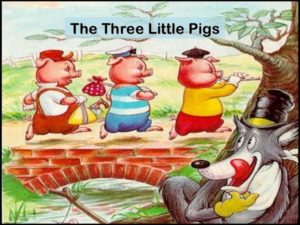How many business owners haven’t worried about the pricing of their goods and services? Not many, I think. We all know it’s a critical factor but are probably frightened of the consequences of getting it wrong. As a result of this fearfulness, we often play ‘safe’, whatever we think that is.
It’s a subject that has been endlessly debated, tested and analysed and there is a wealth of theory available. In this blog, I’m going to take a look at four different approaches and how they can be combined to simplify prices and at the same time increase average sales value.

Power of Three
The human brain appears to naturally break up complex concepts into three parts. This is reinforced in our experience of the world from childhood where we encounter numerous examples of ‘threes’. Fairy story examples include Goldilocks and the Three Bears, Three Little Pigs and the Three Billy Goats Gruff. In Sport we often award Gold, Silver and Bronze medals. Religions such as Christianity, Judaism and Buddhism. Three Primary colours, Neapolitan ice cream; Three quotes in purchasing, the list goes on.
Threes work by simplifying choices; most of us like to have some choice, but too much can be confusing. Other pricing research suggests that when potential customers are unsure or confused, they are more likely to default to the lowest price option, or not purchase at all. Restaurant menus are often grouped into Starters, Mains and Deserts; Supermarket food ranges offer ‘good’, ‘better’ and ‘best’.

2. Price Anchoring
Price Anchoring is the practice of establishing a price point which customers can refer to when making decisions. Effectively, it seeks to fix in customers’ minds a “normal” price against which customers can judge the relative value of other options, savings, discounts, promotions etc.
For example, in a retail environment (real or virtual), when discounts or sale prices are offered, the ‘original’ price is always shown. We subconsciously then accept this is the normal, fair price and focus our attention on the saving rather than the absolute value to us of the item at the discounted cost.
It works for two main reasons. Firstly, outside of pure commodity markets (and even in some of them), people use comparisons or benchmarks to assess the value of products. Secondly, our collective learned behaviour is to find the best reward for the least money or effort. Price anchoring with a high-priced item or original price, makes the medium-priced product, or reduced price seem much better value.
Price anchoring can also work ‘upwards’, although this is less commonly used. If a relatively small additional spend brings apparently many more benefits, the higher priced item looks relatively good value.

3. Bandwagoning
Sometimes, even when both of these techniques are applied, it is still hard for the customer to choose. Perhaps they like more than one option, or don’t feel sufficiently expert. Whatever, the reason, the potential customer is not sure which product or service would be ‘best’ for them at that moment. Again, this can lead to the potential customer deciding not to buy for fear of making the ‘wrong’ choice.
Labelling an option as “most popular”, “best value” or “Chef’s recommendation” reduces anxiety and perceived risk. It makes us feel like we’re doing something lots of other people have done before or is advised by someone who knows more about it than us. It’s the same reason people look at star ratings and reviews on Google, Amazon or Trip Advisor. We may not know any of the reviewers, but if there are enough of them or their comments address a particular concern we have, or demonstrate similar values to us, we feel reassured.
4. Avoidance of extremes
A further fine tuning and combination of these theories is to allow customers to avoid extremes. Most people like to avoid standing out from the crowd (especially if they don’t feel like they are an expert) and so will naturally favour more ‘middle of the road’ options. Coffee shops sell mainly ‘medium’ (or whatever they call them) sized drinks, many people choose the middle-priced quote.

Bringing it all together
All of these ideas can be combined in price communication:
- Promote only three options with different price points. High medium and low, but close enough in price and features for the customer to easily make a comparison – “what more / less do I get for the extra / saving?”
- Don’t expect to sell a lot of the high-priced or low-priced option, so be confident that the middle option delivers the turnover and profitability required
- Add a ‘bandwagon’ label for all three that makes them feel good about their choice
- Make the middle option stand out – bigger, a different colour, font, put a border round it, so the customer’s eye is drawn back to it as well as their rational brain
You can read more Aardvark Marketing tips for setting a pricing strategy here .
To discuss pricing or communication or any other marketing issue affecting your business, please call us on 01905 885 285, send us an email or explore the rest of our website.
